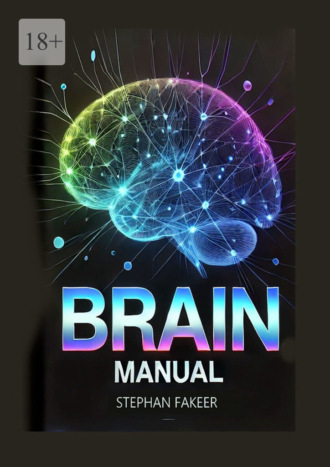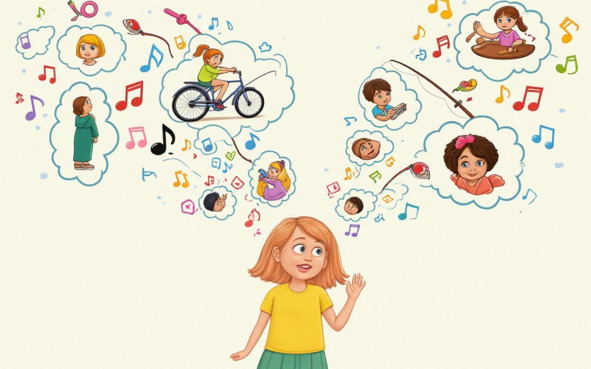
Полная версия
Brain. Manual
Instead, the brain thrives on a varied diet rich in complex carbohydrates. These carbs are gradually converted into glucose, providing steady, long-lasting energy. But what happens if glucose is in short supply? The brain doesn’t panic. It switches to an alternative energy source – ketones. Ketone bodies, derived from fat stores, take over when carbohydrates are temporarily unavailable in the diet. This adaptive state, known as ketosis, enables the brain to perform its tasks just as efficiently on this “backup fuel.”
Exercise: The Brain’s Secret Weapon
Physical activity is a gift to the brain. Activities like walking, running, swimming, cycling, dancing, and even breathing exercises boost brain performance. But it’s important to distinguish between casual exercise and professional sports, where the focus is often on medals and records rather than cognitive health.
When we move, the brain produces its own “internal drugs”:
– Beta-endorphin: a natural opiate that relieves stress and boosts mood.
– Phenylethylamine: a natural stimulant that energizes and improves focus.
– Anandamide: a local cannabinoid that induces feelings of bliss and relaxation.
So yes, that morning jog benefits not just your body but your brain as well!
The Essentials for a Thriving Brain
To keep the brain in top form, it needs three key components: proper nutrition, physical activity, and quality sleep.
– Nutrition: A varied and balanced diet is crucial for supplying the brain with an array of vitamins and nutrients.
–
– Avoid refined sugar: It causes blood sugar spikes, disrupts the absorption of beneficial nutrients, and confuses the brain’s energy regulation.
– Favor complex carbs: These provide slow, steady energy essential for sustained brain function.
– Exercise: Just 30—40 minutes of moderate physical activity per day works wonders. It enriches the brain with oxygen and supplies essential elements to keep it running smoothly.
–
– Sleep: The ultimate “reset button” for the brain, sleep allows it to process information, recharge, and stay sharp.
–
In summary, the brain is a high-maintenance powerhouse that requires proper care. Feed it well, move often, and rest sufficiently to unlock its full potential.

7. Sleep: A Useful and Enjoyable Process
Sleep is like a deep cleaning session for the brain. During this time, “temporary files” are cleared out, and important “data” is transferred to long-term storage. This is when we dream! Dreams can be anything: lucid, chaotic, colorful or black-and-white, pleasant fantasies, or downright nightmares. The content of our dreams depends on how actively the brain is connecting neurons, the state of the body, what we’ve been working on during the day, who occupies our thoughts, and what emotions have stirred us recently. That’s why dreams often seem bizarre, blending distant memories with current events.
The Role of Sleep in Learning
Healthy sleep is essential for anyone studying or acquiring new skills. The brain needs time to transfer newly learned information from “short-term memory” to “archives,” and this process happens during sleep. Additionally, while we rest, the brain’s “cleaning crew” – the glial cells – remove “waste” and toxins, ensuring a tidy neural environment.
Sleep doesn’t just give the brain a break; it primes it for new achievements the following day. If deprived of sleep, the brain becomes prone to errors, misjudgments, and eventually, it may “shut down.” The limbic system even has a fail-safe mechanism to pause the brain in critical situations. So, the best nightly strategy? A proper, uninterrupted sleep!
Why Sleep is Key
Sleep is the cornerstone of optimal brain performance. The ideal sleep routine consists of 8 hours at night and, if possible, an hour-long nap during the day – especially beneficial when learning new material. During sleep, the brain not only organizes memories but also clears out toxins, ensuring it’s ready to function at full capacity the next day.
In short, sleep isn’t just rest; it’s a powerful tool for recharging your brain, boosting productivity, and enhancing cognitive abilities.
8. Consciousness: Your Inner Movie

Human consciousness isn’t just a “brain on” mode – it’s a grand symphony played by billions of neurons (like tiny smartphones) exchanging data received from all your senses. Imagine this: hundreds of billions of axons, trillions of synapses, and dendrites, all forming a network over a million kilometers long – comparable to the global Internet! And all of this operates at lightning speed – 288 km per hour – fueled by countless neurotransmitters that transform this neural activity into a stream of thoughts.
The Stream of Thoughts
Thoughts begin flooding us from early childhood – an endless, swirling noise made up of everything we’ve seen and heard. These thoughts mix and flow like a river, but without clear pictures – more like a film without a screen. That’s how consciousness works, wandering aimlessly and chaotically until given direction.
The moment you set a goal, consciousness shifts gears. It stops wandering and begins working on achieving the target, laser-focused and efficient.
In essence, your consciousness is like a movie projector constantly playing an invisible film. The key to making it meaningful lies in giving it a script – a purpose to guide its boundless creativity and energy.

We All Think Differently
Animals tend to think in images, as do people who use hieroglyphic writing systems – this process is vivid but slow and energy-consuming. In contrast, those using alphabet-based systems think in words and phrases, which is significantly faster. Meanwhile, individuals with highly developed abstract thinking possess the ability to process thoughts in a formless, intangible way, making their mental processes swift and efficient.
A clearly defined goal works like a mental filter: it cuts through the noise and allows you to focus on solving specific tasks. Once a goal is set, your thoughts begin flowing in its direction, interpreting the problem from various angles and perspectives. Interestingly, you’ll start noticing more relevant information connected to your goal, as though your brain is highlighting useful cues for your success. Even after finding a solution, your brain continues to refine and suggest alternative approaches.
How to Set a Goal
It’s not as hard as it sounds. Start by vividly imagining what you need. For example, “a house in Komarovo” or “a new red car.” Then, hold that thought in the background of your mind, free of doubt or insecurity. Simply think: “I need a house in Komarovo.” Keep the emotional tone light, maintaining it as a subtle, persistent undercurrent.
Over time, you’ll find yourself noticing more details, ideas, and opportunities related to your goal. New pathways to achievement will appear, and from there, it’s up to you to choose the one that leads to success. You might even set multiple such goals – it’s far more productive than letting your thoughts aimlessly wander, picking up mental “junk.”
Alcohol and the Stream of Consciousness
One of the most popular (albeit risky) ways people suppress the chaotic flow of consciousness is through alcohol. While effective at silencing mental noise, it comes with serious dangers: alcohol kills neurons, particularly those in the rational part of the brain, which never regenerate. Excessive drinking essentially turns you into a “zombie” – a being with only pre-existing behavioral patterns intact.
Intoxication is a form of poisoning. The limbic system reacts by shutting off the rational part of the brain to conserve energy, leaving these neurons to “starve.” Over time, this results in their permanent loss.
That said, in small doses, alcohol can be harmless, even beneficial, for the brain. This is because the brain itself produces natural “drugs” – endorphins, dopamine, and other pleasure-related chemicals. A small amount of alcohol (roughly 30 grams of pure ethanol over 4—5 hours, like a glass of dry wine in the evening) can quiet unnecessary thoughts and relieve minor mental stress without causing harm.
The Key Is Harmony
Evening gatherings with friends over a single beer can actually be good for your brain, helping to suppress the mental “noise” and promote relaxation. However, the danger lies in overindulgence: binge drinking and alcoholism can devastate your brain, particularly its reasoning areas.
In the end, the brain thrives on balance. A harmonious lifestyle – where small pleasures are taken in moderation and mental clarity is preserved – keeps your brain resilient, focused, and capable of achieving great things.

The Layers of Consciousness: A “Layer Cake” of the Mind
Our consciousness operates like a “layered cake,” with three distinct levels.
– The Oldest Layer: Primary Consciousness
– At the foundation of our consciousness lies the most ancient layer, controlled by the limbic system. This is our “default operating system,” a set of pre-programmed instincts that govern essential survival functions: smell, chewing, swallowing, grasping, reproduction, and dominance. These “ancient codes” are present in all mammals, including humans.
–
– The Second Layer: The Neocortex (“New Cortex”)
– The next layer is the neocortex, or “new cortex,” with its signature grooves and folds. This is where higher mental functions are processed. It activates when we solve complex problems, reflect on our actions, or make plans. The neocortex is our center of self-awareness, intellect, and speech – a defining feature of “Homo sapiens” (the wise human).
–
– The Third Layer: Logical Thinking and Emotional Control
– The pinnacle of consciousness is our ability to think logically, guided by the neocortex. This allows us to partially “switch off” the limbic system, keeping emotions and instincts in check. A well-developed neocortex enables us to make decisions rationally, with a “cool head,” based on reason and analysis rather than instinctive reactions. This balance between reason and emotion is what truly defines us as thinkers.
–
The Creative Power of the Neocortex
The neocortex isn’t just a repository for memories and knowledge. When fully engaged, it becomes a creator – inventing and imagining entirely new concepts that never existed before. It combines diverse ideas, forming unique and innovative solutions. This capacity for creativity and innovation is what makes our brains exceptional.
Decision-Making: A Tug-of-War Between Two inside Voices
Every decision we face comes with two options:
– The Quick Response from the Limbic System
– The limbic system always advocates for the path of least resistance: “Do nothing, save energy, stay safe.”
–
– The Delayed Yet Rational Response from the Neocortex
– Though slower, the neocortex delivers a more thoughtful, balanced, and usually better choice.
–
Example: The phone rings – you’re invited to a party.
– The limbic system quickly suggests: “Let’s go have fun!”
– Meanwhile, the neocortex chimes in: “But you have work tomorrow, and your husband planned a Saturday shopping trip. Maybe it’s better to stay home.”
Decision-making is always a balance between impulsive instinct and rational thought. The goal is to choose the best option for the current situation.
The Consciousness Orchestra
Your consciousness is like an orchestra of 100 billion neurons in your brain, constantly receiving and processing external information before deciding on the best course of action. The better tuned this orchestra is, the more accurate and successful your decisions will be.

9. Learning: The Wild Growth of Synapses and Axons
Our brain starts learning before we even take our first breath – right there in the cozy real estate of the womb. It’s in this pre-birth classroom that the first synaptic connections appear, getting ready for the information tsunami that will hit as soon as we’re born. Slowly but surely, the brain transforms into the most advanced self-learning machine on the planet – a device for discovery that’s completely unmatched.
Конец ознакомительного фрагмента.
Текст предоставлен ООО «Литрес».
Прочитайте эту книгу целиком, купив полную легальную версию на Литрес.
Безопасно оплатить книгу можно банковской картой Visa, MasterCard, Maestro, со счета мобильного телефона, с платежного терминала, в салоне МТС или Связной, через PayPal, WebMoney, Яндекс.Деньги, QIWI Кошелек, бонусными картами или другим удобным Вам способом.



